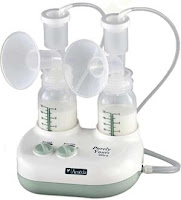Many woman who are breastfeeding experience this and it is normal for your breasts to become larger, heavier, and a little tender when they begin making more milk. Sometimes this fullness may turn into engorgement, when your breasts feel very hard and painful. You also may have breast swelling, tenderness, warmth, redness, throbbing, and flattening of the nipple. Engorgement sometimes also causes a low-grade fever and can be confused with a breast infection. Engorgement is the result of the milk building up. It usually happens during the third to fifth day after birth, but it can happen at any time.
Engorgement can lead to plugged ducts or a breast infection, so it is important to try to prevent it before this happens. If treated properly engorgement should resolve, usually in a couple of days.
These things should help and engorgement usually doesn't last more than a couple of days. Once your body adjusts to the demands of your baby, you might have some leakage and a bit of soreness but it should go away. If you are still having pain or engorgement, it is important that you contact your local breastfeeding support person.
Engorgement can lead to plugged ducts or a breast infection, so it is important to try to prevent it before this happens. If treated properly engorgement should resolve, usually in a couple of days.
Now what?
Breastfeed often after birth, allowing the baby to feed as long as he or she likes, as long as he or she is latched on well and sucking effectively. In the early weeks after birth, you should wake your baby to feed if four hours have passed since the beginning of the last feeding. (This opinion varies, you know your baby best and if they need to sleep longer, use your "mom instincts". They are ususally right!)
Make sure you have a good latch. If you are having trouble or you feel things are not going well,you can contact your nearest Lactation Consultant or La Leche League.
Breastfeed often on the affected side to remove the milk, keep it moving freely, and prevent the breast from becoming overly full.
Avoid overusing pacifiers and using bottles to supplement feedings.
Hand express or pump a little milk to first soften the breast, aereola and nipple before breastfeeding, or use an electric breast pump if you have one, but not for too long. Remember more milk out means more milk you will make! Your body is trying to adjust and make the right amount for your little one.
Massage the breast. This works really well in a nice warm shower. Don't be surprised if you notice milk leaking out if you do this. This is normal and probably will provide some relief.
Use cold compresses in between feedings to help ease pain.
If you are returning to work, try to pump your milk on the same schedule that the baby breastfed at home. Or, you can pump at least every four hours.
Get enough rest, proper nutrition, and fluids.
Wear a well-fitting, supportive bra that is not too tight. Use some breast pads if you feel that you might leak!




 Nancy Mohrbacher
Nancy Mohrbacher





